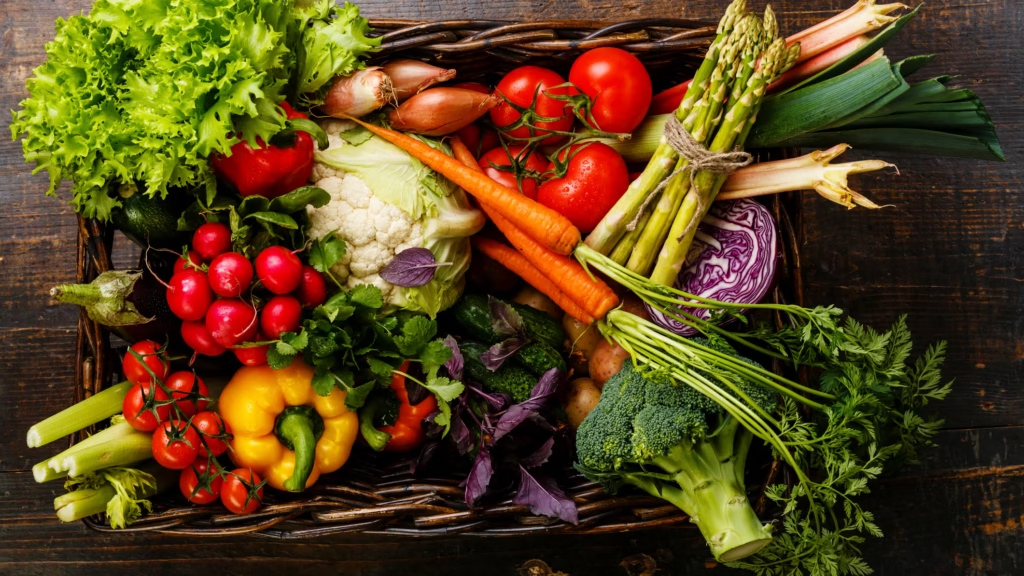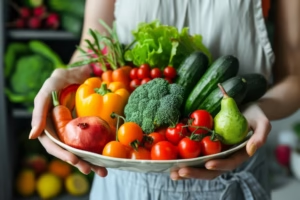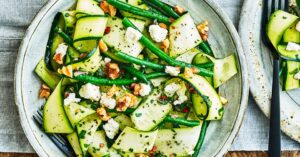Hey there, picture this: It’s a crisp fall morning, and I’m standing in my kitchen, staring down a pile of greens that looks more like a farmer’s market explosion than breakfast. I remember the first time I committed to a veggie-heavy life—back in my mid-30s, after a doctor’s visit where “watch your cholesterol” hit harder than expected. I wasn’t some salad evangelist overnight; it was messy, with more than a few botched kale smoothies that tasted like lawn clippings. But over time, swapping out the drive-thru for plates piled high with color changed everything. Energy that stuck around past noon, clothes fitting looser without the gym grind, and a quiet confidence that comes from knowing you’re fueling your body right. If you’re curious about what a vegetable-rich diet can do for you, stick with me. This isn’t just science—it’s the real, feel-it-in-your-bones difference I’ve lived.
What Is a Vegetable-Filled Diet?
A vegetable-filled diet means putting non-starchy veggies at the heart of your meals—think spinach, broccoli, carrots, and peppers taking up at least half your plate most days. It’s not about going full vegan or ditching everything else; it’s prioritizing produce for its nutrient punch without the calorie overload. Guidelines like those from Harvard’s Nutrition Source suggest aiming for 2-3 cups daily, varying colors for a spectrum of benefits.
This approach feels straightforward once you get the hang of it, but it’s transformative. Back when I started, I tracked my intake with an app, shocked at how little I was really eating before. Suddenly, meals weren’t just fuel—they were vibrant, satisfying adventures.
Key Nutrients in Vegetables and Their Roles
Vegetables pack a powerhouse of essentials that your body craves but often misses in standard diets. Potassium keeps blood pressure in check, fiber smooths digestion, and vitamins like C and A bolster immunity and skin health. Folate supports cell growth, while antioxidants fight off daily wear-and-tear.
I used to pop multivitamins thinking they covered me, but nothing beats the real deal from a crisp bell pepper or steamed Brussels sprouts. It’s like upgrading from economy to first class—your body notices the difference in subtle ways, like fewer colds or steadier moods.
Potassium for Heart Health
Potassium acts as a natural counter to sodium, easing artery strain and lowering stroke risk. Studies show diets rich in it, like those heavy on sweet potatoes or spinach, can drop blood pressure by up to 11 mm Hg—medication-level impact without the pills.
One study from the Nurses’ Health Study followed thousands and linked higher veggie potassium to a 30% slash in heart events. I felt it personally after upping my intake; my annual checkup numbers improved, and that fuzzy fatigue around my temples vanished.
Fiber for Gut Wellness
Dietary fiber in veggies feeds good bacteria, preventing constipation and curbing cholesterol. Aim for 25-30 grams daily, and broccoli or peas can get you halfway there alone.
Research from the American Journal of Clinical Nutrition ties high-fiber veggie eaters to a 15-20% lower heart disease risk. My own gut used to rebel after indulgent weekends—now, with consistent salads, it’s steady as a metronome.
Cardiovascular Protection from Veggie Power
Loading up on vegetables shields your ticker by slashing inflammation and improving vessel flexibility. A veggie-centric plate means fewer plaque buildups and steadier rhythms, turning potential crises into non-events.
I’ve seen friends ignore this until a scare hits; me? Early adoption meant celebrating my 40s with hikes, not hospital visits. It’s empowering, that quiet assurance your choices are building a stronger future.
Reducing Stroke Risk
Veggies like leafy greens cut ischemic stroke odds by 23% when you hit 300 grams daily, per a global meta-analysis. Their nitrates relax blood vessels, boosting flow without spikes.
In one cohort of over 66,000, higher intake correlated with fewer events over decades. Funny how a simple carrot stick feels like armor now.
Lowering Heart Disease Incidence
Ischemic heart disease drops 23% with consistent veggie boosts, thanks to fiber binding bad cholesterol. The DASH diet, veggie-loaded, mimics this in trials.
I swapped fries for roasted roots and watched my lipids improve—proof in the pudding, or should I say, the parsnips.
Weight Management Made Easier
Vegetables are low-cal volume champs: Fill up without the fallout. Their water and fiber content tricks your brain into satisfaction, curbing overeating by 10-15% in studies.
Remember my post-holiday bloat? Veggie swaps melted it off gently—no crash diets, just steady wins that stuck.
Pros and Cons of Veggie-Heavy Eating for Weight Loss
| Aspect | Pros | Cons |
|---|---|---|
| Calorie Density | Low cals, high volume—eat more, weigh less | Can feel bulky if not prepped right |
| Satiety | Fiber keeps hunger at bay longer | Initial adjustment to less processed comfort |
| Sustainability | Natural, affordable long-term | Variety needed to avoid boredom |
| Speed | Quick results without extremes | Slower than fad diets (but safer) |
This table mirrors my trial-and-error: Pros won out once I got creative with flavors.
Cancer Prevention Through Plant Power
Antioxidants in cruciferous veggies like broccoli neutralize free radicals, dialing down cellular damage linked to cancers. Esophageal risk falls 29% with steady intake.
A family history nudged me here—now, I view my weekly stir-fry as quiet rebellion against worry.
Spotlight on Cruciferous Veggies
Sulforaphane in cauliflower activates detox genes, potentially halving colon cancer odds in long-term followers.
I roast them with garlic for that caramelized edge—health with a side of yum.
Boosting Immunity and Fighting Inflammation
Vitamins C and E from peppers and spinach amp white blood cells, shortening colds by a day or two. Chronic inflammation, a silent saboteur, eases with their polyphenols.
During flu season, my veggie stock-up became ritual—fewer tissues, more vitality.
Everyday Immune Heroes
- Bell Peppers: Triple the C of oranges, zingy in salads.
- Garlic: Allicin punches microbes; mince into soups.
- Onions: Quercetin calms inflammation; caramelize for depth.
These aren’t just add-ons—they’re my winter MVPs.
Diabetes Defense Strategies
Veggies stabilize blood sugar via low glycemic loads and fiber that slows absorption. Type 2 risk dips 26% at optimal levels.
A prediabetic wake-up call had me charting carbs via greens—numbers normalized, panic faded.
Glycemic Impact Comparison
| Vegetable | Glycemic Index | Why It Helps Diabetes |
|---|---|---|
| Broccoli | 15 | Minimal spike, high fiber |
| Carrots | 35 (raw) | Beta-carotene bonus |
| Potatoes | 80 (baked) | Starchy—limit portions |
| Spinach | 15 | Leafy insulin friend |
Swapping spuds for greens was game-changing; steady energy, no crashes.
Bone and Muscle Support
Calcium in kale pairs with vitamin K for denser bones, cutting osteoporosis risk. Magnesium aids muscle recovery, key for active folks.
Post-workout soreness? A side of collards fixed that—stronger frame, fewer aches.
Skin and Eye Health Perks
Beta-carotene in carrots guards eyes from age-related blur, while hydration from cukes plumps skin. Lutein in greens fights wrinkles from within.
Vanity alert: My glow-up was real, compliments rolling in without filters.
Top Veggies for Radiance
- Cucumbers: Hydrate and cool puffiness.
- Sweet Potatoes: Vitamin A for that dewy vibe.
- Tomatoes: Lycopene shields from sun damage.
Simple swaps, outsized glow.
Mental Health and Mood Lift
Phytonutrients cross the blood-brain barrier, easing anxiety by 20% in high-intake groups. Folate combats fog.
Stressed? My beet salad ritual grounds me—colorful calm in chaotic days.
Comparison: Veggie Diet vs. Standard American Diet
| Category | Veggie-Filled Diet | Standard American Diet |
|---|---|---|
| Heart Risk | 20-30% lower | Higher saturated fats |
| Weight Gain | Stabilizes, aids loss | Promotes via processed foods |
| Daily Energy | Steady from fiber | Spikes/crashes from sugars |
| Longevity | + years via reduced NCDs | Shorter from chronic ills |
This shift? Night and day—vitality over inertia.
Practical Tips to Amp Up Your Veggie Game
Start small: Add one handful per meal. Roast for flavor, blend into sauces for stealth.
Where to get fresh? Farmers’ markets or CSA programs beat chains for quality and cost.
Best tools? A sharp peeler and air fryer—crisp without oil.
- Shop seasonal: Cheaper, tastier.
- Prep Sundays: Chop and store.
- Flavor hack: Herbs over salt.
My kitchen hack: Veggie bingo—new one weekly keeps it fun.
People Also Ask
Are vegetables healthier than fruits?
Veggies edge out slightly for lower sugar and higher fiber, aiding steady energy and gut health. Both shine, but mix ’em for full spectrum.
How many vegetables should I eat a day?
WHO says 400g minimum—about five servings. Half your plate veggies nails it.
Do frozen vegetables have the same benefits?
Absolutely—nutrients lock in at peak ripeness. Steam over boil to preserve more.
Can too many vegetables be bad?
Rarely, unless oxalate-heavy ones trigger stones in prone folks. Balance rules.
Do vegetables help with weight loss?
Yes—low-cal bulk promotes fullness, cutting overall intake by 200 cals daily.
FAQ
What counts as a vegetable serving?
One cup raw or half-cup cooked. Leafies like lettuce? Two cups. Easy math for big wins.
How do I make veggies taste better without calories?
Roast with balsamic, air-fry with paprika, or blend into pestos. My garlic-lemon broccoli? Addictive.
Can a veggie diet replace exercise for health?
No—synergy’s key. Veggies fuel, movement builds. Together? Unstoppable.
Are organic veggies worth the extra cost?
They reduce pesticide exposure, but conventional washed well works too. Prioritize thin-skinned like berries.
How soon do benefits kick in?
Gut shifts in days, weight in weeks, heart markers months. Patience pays dividends.
Wrapping this up, that kitchen chaos from years back? It’s my victory garden now. A vegetable-filled life isn’t restriction—it’s abundance, color on your plate and spark in your step. You’ve got the tools; what’s your first green bite today? Trust me, your future self will thank you with a wink and a whole lot more pep.




